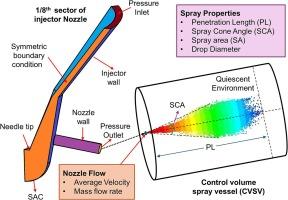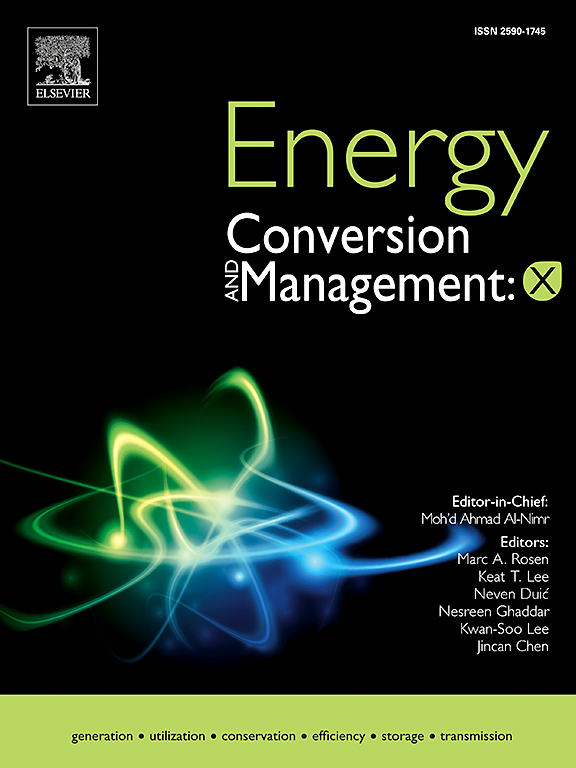Investigation of in-nozzle flow behavior coupled with spray characteristics of waste cooking oil and castor biodiesel
IF 7.6
Q1 ENERGY & FUELS
引用次数: 0
Abstract
Biodiesel is a promising alternative to conventional diesel. However, it may cause reduced mass flow, higher injector deposits and poor atomization. This study presents the numerical investigation of the effect of in-nozzle flow on fuel spray behavior for castor methyl ester (CME20) and waste cooking oil methyl ester (WCME20) using two different nozzle hole sizes. Two step simulation methodology was adopted where flow inside the nozzle was simulated first, mass flow rate and velocities at nozzle outlet were used as an input for analyzing the fuel spray in a closed vessel. These simulated results of fuel spray were also validated with experimental results from the captured spray images from control volume spray vessel (CVSV). Experimental spray results were also investigated based on light intensity level and macroscopic spray properties. Results revealed higher cavitation intensity for diesel than biodiesel fuels. Smaller nozzle hole (N2) is more likely to cavitate as compared to larger nozzle diameter (N1). In terms of spray behavior, N1 nozzle on average showed longer penetration length (+1.95 %), wider spray cone angle (+6.2 %) and larger drop diameter (+3.1 %) in comparison to N2. CME20, due to its increased viscosity and density showed longer penetration length (+5.9 %), narrower spray cone angle (−21 %) and reduced spray projected area (−19 %) with respect to diesel. WCME20 revealed smaller sauter mean diameter (−4.8 %) as compared to CME20 owing to its lower viscosity.

废食用油和蓖麻生物柴油喷嘴内流动行为及喷雾特性研究
生物柴油是一种很有前途的传统柴油替代品。然而,生物柴油可能会导致质量流量降低、喷油器沉积物增加和雾化不良。本研究采用两种不同的喷嘴孔径,对蓖麻油甲酯(CME20)和废食用油甲酯(WCME20)的喷嘴内流动对燃料喷雾行为的影响进行了数值研究。采用了两步模拟方法,首先模拟喷嘴内的流动,然后将喷嘴出口处的质量流量和速度作为分析封闭容器中燃料喷雾的输入。这些燃料喷雾的模拟结果还与控制体积喷雾器(CVSV)捕获的喷雾图像的实验结果进行了验证。实验喷雾结果还根据光照强度水平和宏观喷雾特性进行了研究。结果显示,柴油的空化强度高于生物柴油燃料。与较大的喷嘴直径(N1)相比,较小的喷嘴孔(N2)更容易发生气蚀。在喷雾行为方面,与 N2 相比,N1 喷嘴平均显示出更长的穿透长度(+1.95 %)、更宽的喷雾锥角(+6.2 %)和更大的液滴直径(+3.1 %)。与柴油相比,CME20 因其粘度和密度的增加而显示出更长的穿透长度(+5.9 %)、更窄的喷射锥角(-21 %)和更小的喷射面积(-19 %)。由于 WCME20 的粘度较低,与 CME20 相比,WCME20 的平均直径更小(-4.8%)。
本文章由计算机程序翻译,如有差异,请以英文原文为准。
求助全文
约1分钟内获得全文
求助全文
来源期刊

Energy Conversion and Management-X
Multiple-
CiteScore
8.80
自引率
3.20%
发文量
180
审稿时长
58 days
期刊介绍:
Energy Conversion and Management: X is the open access extension of the reputable journal Energy Conversion and Management, serving as a platform for interdisciplinary research on a wide array of critical energy subjects. The journal is dedicated to publishing original contributions and in-depth technical review articles that present groundbreaking research on topics spanning energy generation, utilization, conversion, storage, transmission, conservation, management, and sustainability.
The scope of Energy Conversion and Management: X encompasses various forms of energy, including mechanical, thermal, nuclear, chemical, electromagnetic, magnetic, and electric energy. It addresses all known energy resources, highlighting both conventional sources like fossil fuels and nuclear power, as well as renewable resources such as solar, biomass, hydro, wind, geothermal, and ocean energy.
 求助内容:
求助内容: 应助结果提醒方式:
应助结果提醒方式:


